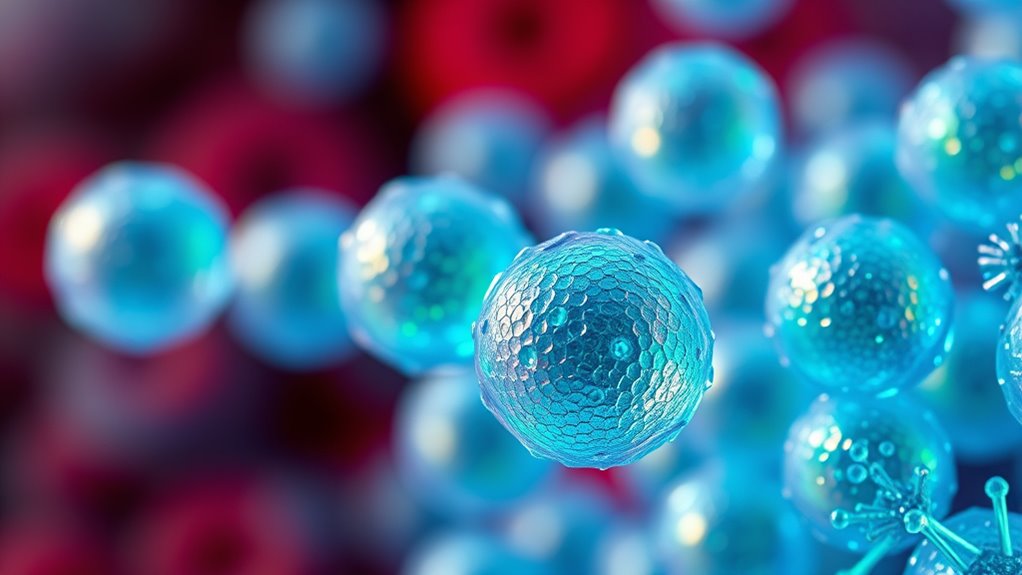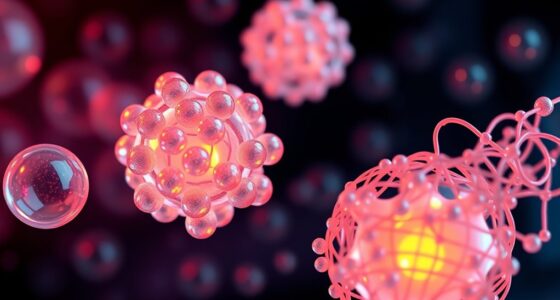Nano vaccines and immunotherapy use tiny particles to deliver antigens effectively, boosting your immune response. They protect vaccines from degradation, enable targeted delivery, and can stimulate long-lasting immunity. Different nanomaterials like liposomes, polymers, and inorganic particles help improve safety and effectiveness. These advanced systems fight infectious diseases and cancer more efficiently while reducing side effects. Discover how ongoing innovations make nano immunotherapy a promising frontier for health, if you explore further.
Key Takeaways
- Nano vaccines utilize nanometer-sized particles to enhance antigen delivery, improve immune responses, and reduce side effects compared to traditional vaccines.
- Different nanomaterials, such as liposomes, polymer-based, and inorganic nanoparticles, enable targeted and controlled delivery of vaccines and immunotherapeutic agents.
- Nano immunotherapy improves treatment for infectious diseases and cancer by enhancing immune cell targeting, activation, and sustained immune stimulation.
- Challenges include ensuring nanomaterial safety, stability, precise targeting, and navigating regulatory approval processes.
- Future trends focus on personalized, AI-driven multi-functional nanocarrier systems for optimized and safer vaccines and immunotherapies.
The Science Behind Nano Vaccines

Nano vaccines utilize tiny particles, often on the scale of nanometers, to deliver antigens and stimulate the immune system more effectively. These nanoparticles are engineered to protect the antigens from degradation, ensuring they reach your immune cells intact. When administered, the particles interact with immune cells like dendritic cells, enhancing recognition and response. The small size allows the vaccine to penetrate tissues and cells more easily, increasing efficiency. Additionally, nano vaccines can be designed to release antigens gradually, providing sustained stimulation. This targeted delivery not only improves the vaccine’s effectiveness but also reduces side effects. By harnessing the unique properties of nanomaterials, these vaccines activate your immune system in a more precise and potent manner, paving the way for advanced immunotherapies. Understanding the resources and tools available for developing and deploying nano vaccines can help optimize their design and application.
Types of Nanomaterials Used in Immunotherapy
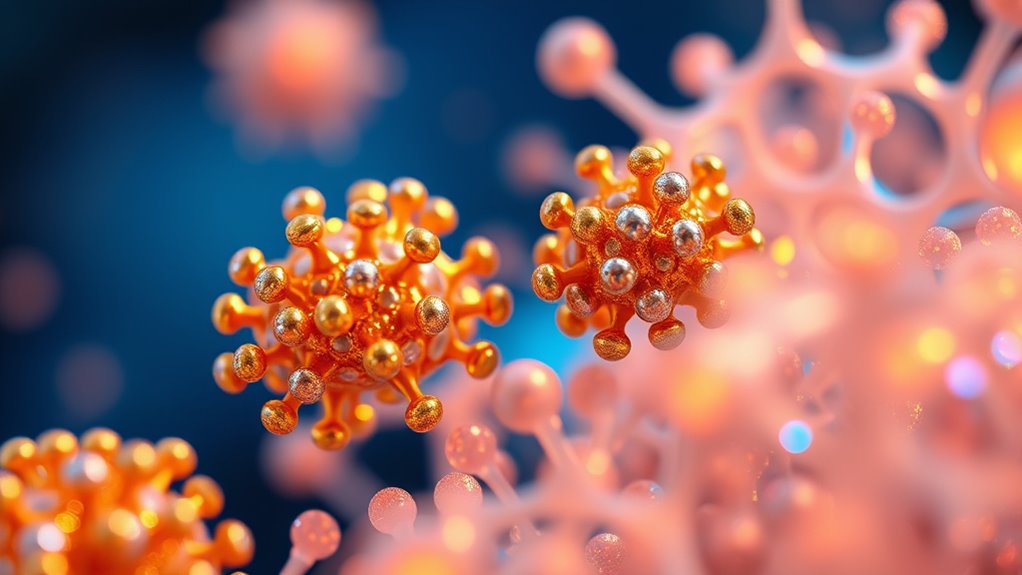
A variety of nanomaterials serve as the foundation for innovative immunotherapies, each offering unique properties that enhance vaccine delivery and immune activation. Liposomes are widely used because they can encapsulate both hydrophilic and hydrophobic agents, protecting them until they reach target cells. Polymer-based nanoparticles, like PLGA, provide controlled release and biodegradability, making them suitable for sustained immune stimulation. Inorganic nanomaterials, such as gold or silica nanoparticles, are valued for their stability and ease of functionalization, allowing you to attach antigens or adjuvants directly. Carbon-based nanomaterials, including graphene oxide, offer high surface area for loading multiple molecules. Selecting the appropriate nanomaterial depends on your specific therapeutic goals, ensuring efficient delivery and robust immune responses. Monitoring of nanomaterials’ stability and safety is essential for their successful application in immunotherapy.
Advantages of Nano-Enabled Vaccines
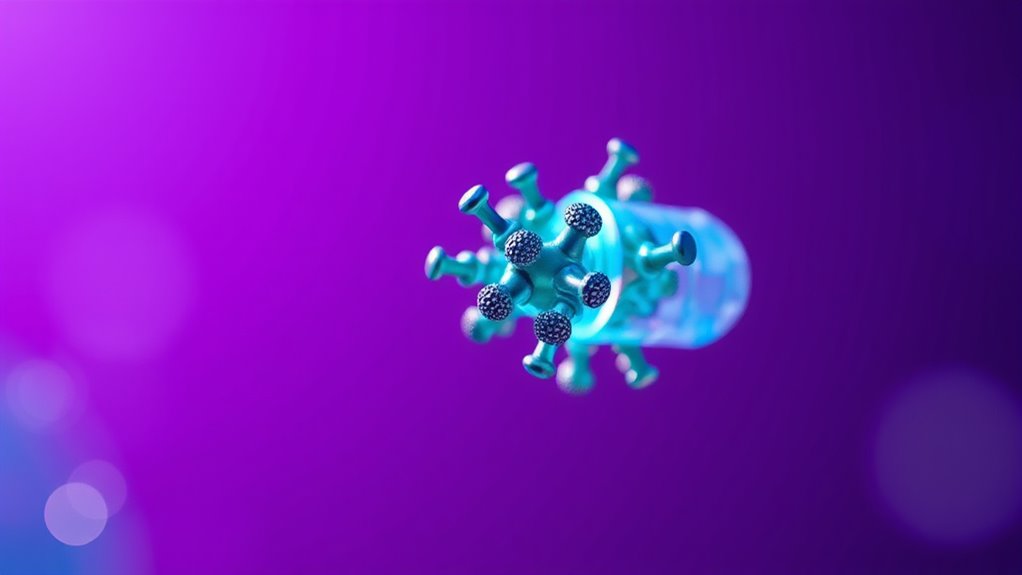
Have you ever wondered how nano-enabled vaccines enhance immune responses compared to traditional ones? They offer several key advantages. First, their small size allows for better cellular uptake, ensuring your immune system recognizes the threat faster. Second, nano vaccines can be tailored to deliver antigens more effectively, increasing the strength of your immune response. Third, they often require lower doses and fewer boosters, making vaccination more efficient. Additionally, color accuracy plays a significant role in the visual presentation of vaccine data and illustrations. Here’s a quick comparison:
| Feature | Traditional Vaccines | Nano-Enabled Vaccines | Benefits |
|---|---|---|---|
| Size | Larger particles | Nanoscale | Better cell penetration |
| Delivery Efficiency | Moderate | High | Stronger immune activation |
| Dosing | Multiple doses | Fewer doses | Increased compliance |
These advantages make nano vaccines promising tools for more effective, targeted immunization.
Strategies for Targeted Delivery

Building on the advantages of nano-enabled vaccines, targeted delivery strategies focus on directing these nanoparticles precisely to specific cells or tissues. This precision enhances vaccine efficacy and reduces side effects. To achieve this, you can employ various approaches:
Targeted delivery of nano vaccines boosts efficacy and minimizes side effects.
- Functionalizing nanoparticle surfaces with ligands or antibodies that recognize specific cell markers.
- Modifying particle size and charge to improve accumulation at the target site.
- Utilizing stimuli-responsive systems that release the payload in response to pH, enzymes, or temperature changes.
- Incorporating vetted formulations that are proven safe and effective for targeted delivery methods.
These strategies guarantee your nano vaccines reach the intended cells, boosting immune responses efficiently. By carefully designing delivery systems, you maximize therapeutic benefits while minimizing off-target effects. This targeted approach is vital in advancing personalized immunotherapy solutions.
Nano Vaccines in Combating Infectious Diseases

Nano vaccines improve delivery efficiency, ensuring your immune system receives the right dose precisely where needed. They also target immune cells more effectively, activating defenses against infections swiftly. Plus, their design reduces side effects, making vaccination safer and more tolerable. Incorporating goal setting techniques can further optimize vaccination strategies by aligning research objectives with patient outcomes.
Enhanced Delivery Efficiency
How can nano vaccines maximize their impact against infectious diseases? They do this by greatly improving delivery efficiency, ensuring the vaccine reaches the right cells quickly. Nano-sized carriers can traverse biological barriers that traditional vaccines cannot, increasing the chances of effective immune activation. To enhance delivery, focus on:
- Surface modification: Adding targeting ligands directs nano vaccines to specific immune cells.
- Controlled release: Engineering particles for sustained antigen release prolongs immune stimulation.
- Size optimization: Smaller particles improve uptake by cells and facilitate better distribution within the body.
- Monitoring and safety measures: Ongoing AI safety assessments are vital to ensure the responsible development and deployment of nano vaccines, minimizing potential risks associated with novel nanotechnologies.
These strategies make nano vaccines more potent by ensuring higher bioavailability and precise delivery, reducing doses needed and minimizing side effects. Enhanced delivery efficiency is crucial to fighting infectious diseases more effectively and rapidly.
Targeted Immune Activation
Have you ever wondered how nano vaccines can specifically activate the immune system against infectious agents? Nano vaccines are designed to target key immune cells, such as dendritic cells, by attaching ligands or antibodies that recognize these cells. When administered, they deliver antigens directly to the immune system’s most effective activation sites. This targeted approach guarantees a robust and precise immune response, minimizing unnecessary activation of other immune pathways. By focusing on specific cell types, nano vaccines enhance the production of antibodies and activate T cells more efficiently. This precision not only boosts vaccine effectiveness but also reduces the likelihood of adverse reactions. Additionally, understanding immune system targeting strategies can lead to the development of more effective immunotherapies. Ultimately, targeted immune activation helps you achieve stronger, more focused protection against infectious diseases.
Reduced Side Effects
Because nano vaccines target specific immune cells, they substantially reduce the risk of side effects commonly associated with traditional vaccines. By focusing on precise immune responses, you experience fewer adverse reactions like fever or swelling. Nano vaccines also minimize unnecessary exposure to other tissues, lowering the chance of unintended immune activation. This targeted approach enhances safety, especially for vulnerable populations. Here are three reasons why reduced side effects matter:
- Fewer allergic reactions and discomfort post-vaccination
- Lower risk of adverse immune responses
- Increased vaccine acceptance and compliance
Additionally, targeting spiritual energy and fostering energetic balance can contribute to overall health and well-being, supporting the immune system’s optimal function.
Nano-Driven Approaches in Cancer Immunotherapy
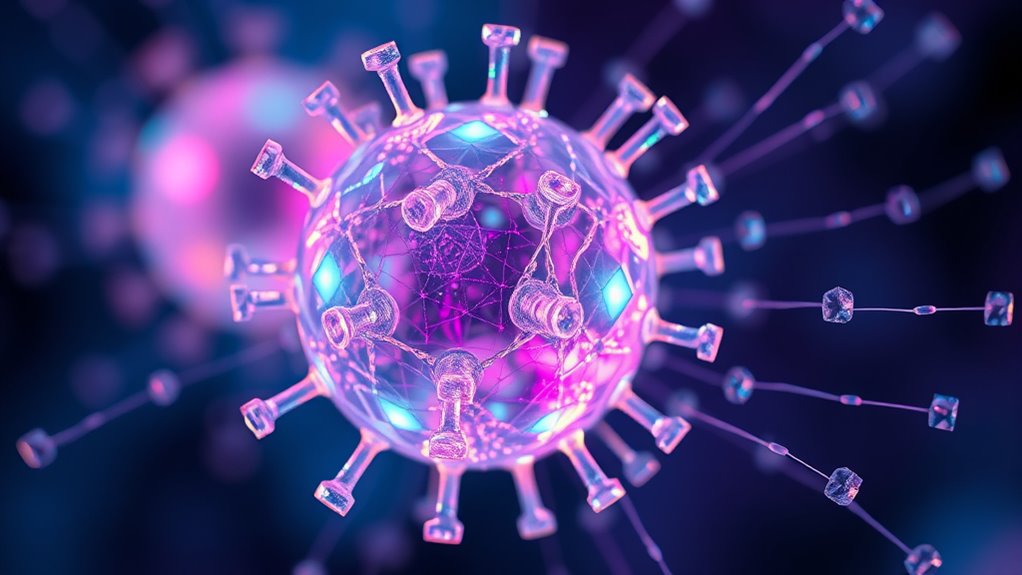
Nano-driven approaches in cancer immunotherapy offer precise targeting of tumor cells, increasing treatment accuracy. They also boost immune activation, helping your body recognize and attack cancer more effectively. Plus, these methods can minimize side effects by reducing damage to healthy tissues. Additionally, advanced delivery systems such as airless spray technology facilitate efficient administration of therapeutic agents with minimal overspray and waste.
Enhanced Targeting Capabilities
Enhanced targeting capabilities are transforming cancer immunotherapy by allowing nano-based systems to deliver therapeutic agents directly to tumor cells with greater accuracy. These advanced nanocarriers can recognize and bind to specific cancer markers, minimizing damage to healthy tissue. This precision improves treatment efficacy and reduces side effects. To achieve this, nano systems often utilize surface modifications, such as ligands or antibodies, that specifically target tumor-associated antigens. This targeted approach offers several advantages:
- Increased accumulation of drugs at the tumor site
- Enhanced penetration into tumor tissues
- Reduced off-target effects and toxicity
- Real-time monitoring capabilities further optimize delivery and treatment outcomes.
Improved Immune Activation
Improved immune activation is a key advancement in nano-based cancer immunotherapy, enabling more effective stimulation of the body’s natural defenses against tumors. Nano platforms can deliver antigens and adjuvants directly to immune cells, enhancing their response. They facilitate better uptake by dendritic cells, leading to stronger T cell activation and increased cytokine production. This targeted approach ensures the immune system recognizes and attacks cancer cells more efficiently. Additionally, nano carriers can be engineered to release their payloads in response to specific tumor microenvironment cues, prolonging immune stimulation. The result is a more robust and sustained immune response, which can overcome tumor immune evasion mechanisms. Overall, nano-driven strategies markedly boost immune activation, offering promising avenues to improve cancer immunotherapy outcomes.
Reduced Side Effects
By precisely targeting cancer cells and their microenvironment, nano-driven approaches considerably reduce the side effects commonly associated with traditional immunotherapies. These methods deliver drugs directly to tumors, minimizing damage to healthy tissue. As a result, you experience fewer adverse effects, such as inflammation or immune-related complications. Nano-delivery systems also enable controlled release, maintaining ideal therapeutic levels without overexposure. This targeted precision offers several benefits:
- Reduced toxicity and fewer side effects
- Enhanced patient comfort and compliance
- Decreased risk of systemic immune reactions
Challenges and Safety Considerations
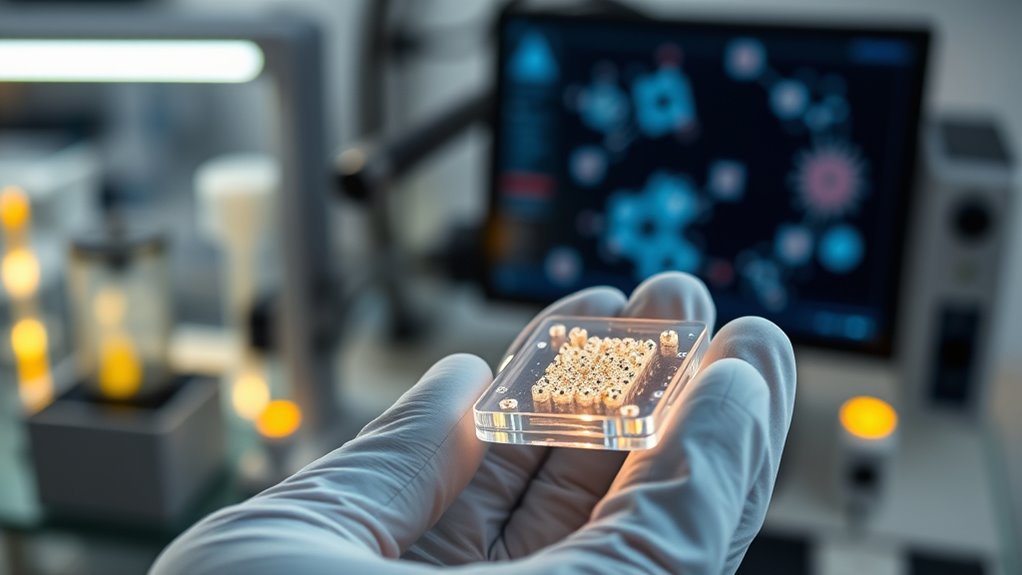
Despite the promising potential of nano vaccines and immunotherapy, several challenges and safety concerns need careful consideration. You must guarantee the stability of nanomaterials, as they can degrade or aggregate, affecting efficacy and safety. Targeting precision is another hurdle; delivering nanoparticles specifically to intended cells without off-target effects is complex. Additionally, you should be aware of potential toxicity issues, as some nanomaterials may induce immune reactions or accumulate in organs, causing long-term harm. Manufacturing consistency and scalability also pose challenges, requiring rigorous quality control to ensure safety and effectiveness across batches. Regulatory frameworks are still evolving, so you need to navigate uncharted legal and safety landscapes. Addressing these challenges is essential for safe, successful integration of nano vaccines into clinical practice.
Future Perspectives and Emerging Trends

As research advances, the future of nano vaccines and immunotherapy looks promising, driven by innovative materials and delivery strategies. You can expect emerging trends to focus on personalized treatments, improved targeting, and enhanced immune responses. Nano-engineered platforms will become more adaptable, allowing you to customize vaccines for individual needs. Additionally, new nanomaterials will facilitate better stability and controlled release, making therapies more effective.
Key trends include:
- Integration of artificial intelligence to optimize vaccine design and delivery.
- Development of multi-functional nanocarriers that combine diagnostics and therapy.
- Expansion of nano-based immunotherapies for various cancers and infectious diseases.
These advancements will revolutionize your ability to prevent and treat diseases more precisely and efficiently.
Frequently Asked Questions
How Do Nano Vaccines Differ From Traditional Vaccines?
Nano vaccines differ from traditional vaccines because they use tiny particles to deliver antigens more efficiently. You’ll notice they can target specific cells better, trigger stronger immune responses, and often require smaller doses. Unlike conventional vaccines, which may need refrigeration and multiple shots, nano vaccines can be more stable and potentially administered less frequently. This innovative approach improves effectiveness and accessibility, making immunization more efficient and adaptable.
Are Nano Vaccines Suitable for All Age Groups?
About 60% of new vaccine developments target diverse age groups, and nano vaccines are increasingly suitable for all ages. You can feel confident that these vaccines are designed to be safe and effective across different demographics, including children and seniors. Researchers tailor nano vaccines to enhance immune responses, making them a versatile option for everyone. So, whether you’re young or old, nano vaccines could be a valuable addition to your health protection.
What Are the Cost Implications of Nano Vaccine Development?
You’ll find that developing nano vaccines can be costly due to advanced materials, sophisticated manufacturing processes, and rigorous testing. These expenses often lead to higher prices initially, impacting accessibility. However, as technology advances and production scales up, costs may decrease over time. Investing in nano vaccine development can be financially demanding upfront, but it promises long-term benefits by potentially offering more effective and targeted immunization options.
How Long Does Immunity Last After Nano Immunotherapy?
Your immunity after nano immunotherapy can last for months to years, depending on your body’s response and the specific treatment. Sometimes, it’s like a fortress that stands strong for a long time, but other times, it may weaken sooner, requiring booster shots. The durability varies widely, so regular check-ups help monitor your immunity levels and determine if additional treatments are needed to keep you protected.
Can Nano Vaccines Be Integrated With Existing Vaccination Programs?
Yes, nano vaccines can be integrated into existing vaccination programs. They offer improved delivery, enhanced stability, and targeted immune responses, making them a valuable addition. You can incorporate nano vaccines alongside current vaccines, potentially increasing efficacy and reducing doses. Healthcare providers need to adapt protocols and educate staff, but the integration could streamline immunization efforts and provide better protection against diseases.
Conclusion
As you explore nano vaccines and immunotherapy, you realize how tiny tools open vast possibilities. Just like how a small spark ignites a flame, these nanomaterials could revolutionize disease treatment. With each new discovery, you see a future where infections and cancers become conquerable. It’s incredible to think that within these minute particles lies the potential to transform medicine, turning hope into reality—proof that sometimes, the smallest innovations can make the biggest impact.
